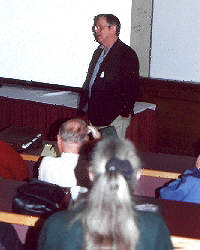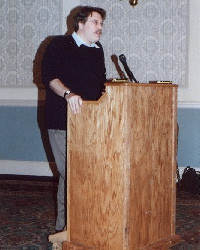New England Chapter No. 8 NAWCCWINTER MEETING, SATURDAY, FEBRUARY 10, 2001Sturbridge Host Hotel, Sturbridge MassachusettsPhoto Highlights by Bob Frishman Meeting Highlights by Dave Deutermann
Chapter Eight's Winter meeting was held February 10th at the Sturbridge Host Hotel in Sturbridge, MA. Mart tables were a bit sparse at 65+, but made up for it in quality. We had two well-attended workshops, the first of which was presented by Richard Monaco, a 4th generation furniture maker from Brimfield, MA. Richard brought with him an exact duplicate of an original Simon Willard "coffin " clock case which he was commissioned to make by the owner of the antique original, plus a selection of the hand tools used in the construction. This case was to be as exact a copy as possible, including poor dovetailing layout and crude fastenings. Richard started by making dimensioned drawings of the various parts of the case assembly plus wood patterns of the pediment and block standoffs for the dial mounting board. In constructing such a case, Richard recommends, if possible, to get all the wood out of a single board, as this insures the same wood grain, same color and reaction to stain. This case lumber was resawn from 5/4" walnut, and featured a bookmatch grain pattern for the front case panel, as the case was too wide for a single board panel. The "coffin" carcase was built first, following the original dovetail pattern, and the resulting assembly was then rabbeted for the back panel. The standoff blocks for the dial support were then glued on per the pattern, followed by strengthening corner blocks throughout. Old-style hide glue was used exclusively. The pediment was then sawn to pattern and shaped to final profile using rasps and files. The finish stain was water-based aniline dye followed by final French polishing. The result was pure elegance. Richard then unveiled another coffin case, identical except in birchwood, with all the construction weaknesses corrected and built using modern machine tools where this made sense. Yellow carpenter's glue was used in this version. The case was then lacquered. Again an elegant case, dimensionally identical to the first yet very different in appearance, and much faster in the construction. Our second presentation of the morning was courtesy of Chapter member Tom McIntyre, who took us through thee development of the Marine Chronometer, 1714-1942. Tom started with a broad-brush review of the longitude problem and the chronology of John Harrison's efforts to devise an accurate timepiece that would meet three key requirements, e.g. insensitivity to the power available to drive the regulator, insensitivity to temperature and the ability to survive a harsh environment. The design effort progressed from the enormous H1 apparatus in 1735 to the "almost pocketwatch" sized H4 in 1754, his finalist for the Board of Longitude prize. Still remaining were the problems of non-isochronism, the "middle temperature" error and the need for oil, which degraded rapidly on long sea voyages. France's Pierre le Roy had already devised the first bimetallic compensated balance in 1766, as well as a mercury/alcohol thermometer compensation scheme plus invented the first pivoted detent detached escapement. Unaware of this prior work, England's Thomas Earnshaw designed another spring detent detached escapement in 1780, followed rapidly by John Arnold's version in 1783. This escapement is not pivoted and thus eliminates the need for pivot oil. Arnold further devised a gold hairspring which solved the non-isochronos steel hairspring problem. Remaining throughout the 1800's was the middle temperature error, whereby correcting the upper and lower expected temperature extremes results in a significant error in the middle of the range. This was finally solved at the turn of the century by the French invention of Elinvar, a nickel-iron alloy that results in a hairspring and balance which are insensitive to temperature. Likewise the oil degradation problem was ultimately solved by the development if synthetic oils. Adjoining for the luncheon following the workshops, the annual Chapter Eight business meeting was convened and a slate of candidates was presented to the membership for election to Council vacancies. There being no nominations from the floor, the slate candidates were elected by voice vote. Our luncheon speaker was Jonathan Snellenburg, familiar to many as an appraiser on "Antiques Roadshow" and currently owner of a NYC gallery. Mr. Snellenburg's talk, titled "Science as Art: a social history of timekeeping" covered the gradual development of society's concepts of time and timekeeping from the first mechanical clocks and watches introduced in the 16th century as artistic jewelry to today's iron rule of timekeepers in regulating our very lives. Many 16th century portraits of important individuals prominently included the watch or clock, symbolizing the relentless passage of time. Worn as jewelry, they hinted at ultimate mortality and the allotment of a finite measure of time to our lives. Beginning in the 18th through the 19th centuries, there were four stages in the development of clocks and watches, first as observatories or observational devices, next as calculators in the astronomical sense, then as measuring devices and finally as life-regulating devices. As observatories, highly ornate dials emphasized the passage of day into night and the months were defined by moon phase. With improvements in gearing, subsidiary dials further demonstrated the inticacies of celestial events and calculated their time of occurrence. Eventually, with Huygen's adaptation of Galileo's pendulum to the clock, the resulting quantum jump in accuracy resulted in truly accurate and useful time measuring devices, and clock time superceded local solar time as the measure of a day. Finally with the development of portable and accurate timepieces, society has allowed the clock to regulate our lives. Mr Snellenburg's talk was accompanied by a slideshow of some beautiful clocks and watches, and was enjoyed by all. * * * The hotel is located opposite Old Sturbridge Village on Route 20 Directions: Those desiring overnight lodging should contact the hotel directly at 1-800-582-3232 or 508-347-7393. Registrations before February 3, 2001 are $18.
Election of chapter officers President - Bob Frishman Officers whose terms remain unexpired are Joe Delaney and John LeLievre. President's Message - Larry Chelmow As of this meeting, my term as President is over. I am pleased to have been able to serve you and hope to be able to continue serving the Chapter. I would like to thank you all for your comments over the four years I have served as 1st VP and President and for making this a great experience. As always, please feel free to call me with any comments or criticisms. (781) 828-1626 |
||||||||||||||||||||||||||||



